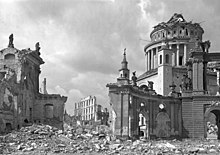Air raid on Potsdam

The air raid on Potsdam , also known as the “ Night of Potsdam ”, took place on April 14, 1945 from 10:16 pm. Large parts of the city center were destroyed. Very soon after the air raid alarm , 490 heavy four-engine Lancasters of the British Royal Air Force dropped approx. 1700 tons of bombs (high explosive bombs, mine bombs, incendiary bombs). 1593 Potsdamer died in the bombardment or afterwards in the sea of flames, almost 1,000 buildings in the city center were completely destroyed and around 60,000 people were made homeless.
Events

According to Allied information, the then city station was the main target. But this was militarily uninteresting. The amount of bombs, the high number of incendiary bombs used and the marking of the old town as a target area with four light bombs - the train station was on the edge of the target area - indicate the targeted destruction of the old town. This was confirmed by Royal Air Force records handed over after 1990. The main target was the old town of Potsdam. Most of the southern and eastern Potsdam old town and the area northeast of the Brauhausberg were hit and suffered severe damage. The city palace , the garrison church and other important buildings in the city burned down. Large parts of the Berlin suburb went up in flames and parts of Babelsberg were also hit. The Reichsarchiv on the Brauhausberg burned out. Up to 97% of the buildings in downtown Potsdam and the Berlin suburbs were destroyed or damaged. Babelsberg got off comparatively lightly with a destruction or damage rate of 23%.
Some valuable buildings survived the “Night of Potsdam”, but were badly damaged. These include the Nikolaikirche and the old town hall on the old market - which were restored after the war - the Holy Spirit Church , which was demolished after 1945, and the playhouse in the eastern old town and the Monopteros on the military orphanage in the Breite Straße. However, the fighting over Potsdam continued. When the city was declared a " fortress ", observer posts occupied the highest vantage points. These were particularly hard hit by the days of artillery bombardment by Soviet troops around April 24; many other structures that had been preserved up to then went up in flames and thus also lost. Only the parks and their castles were spared major damage.
memory
Burial and memorial sites in the New Cemetery
At the New Cemetery there is a large memorial ("Bomb Sacrifice Fields" I and II) with individual and mass graves for citizens of Potsdam who were buried here in 1641 and who mostly died on the night of April 14th to 15th, 1945. Bomb Victims Field I: 341 individual graves of the victims of individual bomb attacks 1939–1945. The granite crosses were set in 1993. Bomb casualty field II: 1,370 dead from 1943–1945. Most of them are victims of the bombing raid on April 14, 1945; but also deaths from the last days of the war in and around Potsdam, soldiers, civilians, foreigners. A 1979 memorial bears the inscription: THE MEMORY OF THE VICTIMS OF THE BOMB ATTACK ON POTSDAM ON APRIL 14, 1945
At the Goethestrasse cemetery in Babelsberg there is a memorial stone for 44 residents of the district who died in the night of the bombing.
Memorial events
A memorial rally at the Nauener Tor commemorated the events of that night on April 14, 2006 .
On April 14, 2013, the “Potsdam Requiem”, composed by the local cantor Björn O. Wiede, was premiered in the Nikolaikirche . The eight-part work for an instrumental ensemble, choir and soloist with chamber music takes some formal borrowings from Britten's War Requiem and relies on the effects of minimal music .
See also
- Arado aircraft works
- Orenstein & Koppel - especially the "Märkische Lokomotivfabrik Orenstein & Koppel oHG"
- List of Allied air raids on the German Reich (1939–1945)
literature
- Dieter Schulte, Hartmut Knitter: Potsdam in the Picture of History, Part 1, From the Beginnings to 1945 . Ed .: Directorate of the Potsdam District Museum 1979.
- Hans-Werner Mihan: The night of Potsdam: the air raid by British bombers on April 14, 1945; Documentation and experience reports . Vowinckel, Berg am Starnberger See 1997, 200 pages, ISBN 3-921655-83-8 .
Web links
- Günter Schenke: Night of the Bomb: Remembrance and Questions , Potsdam Latest News from April 14, 2008
- The minutes of the bombing night in Potsdam , Märkische Allgemeine from April 14, 2015
- Commemorative service by the Lord Mayor of Potsdam, Jann Jakobs , press release (2010)
- Night of Potsdam - Article at PotsdamWiki
Footnotes
- ↑ According to research from 2014/15, there were no so-called Christmas trees . The minutes of the bombing night in Potsdam , in Märkische Allgemeine , April 14, 2015.
- ↑ Dieter Bingen, Hans-Martin Hinz (ed.): The loop: Destruction and reconstruction of historical buildings in Germany and Poland , Harrassowitz 2005, p. 154 ( online ). According to this source, the then Gauleiter ( Emil Stürtz ) declared the city a fortress. According to Mihan (Hans-Werner Mihan: Die Nacht von Potsdam. The air raid by British bombers of April 14, 1945 , 1997, p. 96), Stürtz managed in March 1945 at the Fuehrer's headquarters that the defensive ring around Berlin, which had been withdrawn from Nikolassee , was extended to Potsdam and Potsdam was declared a fortress.
- ↑ https://www.friedhof-in-potsdam.de/friedhoefe/neuer-friedhof-potsdam/
- ↑ https://www.denkmalprojekt.org/2014/potsdam-neuer-friedhof_brb.html
- ↑ Impressive death lament by Björn O. Wiede's “Potsdam Requiem” premiered in the Nikolaikirche. In: PNN - Potsdam Latest News. April 16, 2013, accessed January 23, 2020 .







